An Experimental Study on the Effect of Cutting Angle on the Growth of Grafted Watermelon Seedlings Using the One-Cotyledon Grafting Method
Abstract
1. Introduction
2. Materials and Methods
2.1. Seedling Production
2.2. The Cutting Device and Usage
2.3. The Cutting Angle Design
2.4. Grafting and Healing
2.5. Assays of Phloem and Xylem Connectivity
Xylem reconnection rate (%) = (xylem reconnected grafts/total test grafts) × 100%.
2.6. Calculation of Adhesion Force
2.7. Grafted Survival Measurement
2.8. Measurement of Morphological Index
2.9. Data Analyses
3. Results
3.1. Measurement of Phloem and Xylem Connectivity Rate of Rootstock and Scion Cutting with Different Angles on Different Days after Grafting
3.2. Measurement of the Adhesion Force of Grafting Unions Cut at Different Angles on Different Days after Grafting
3.3. Survival Rates of Grafting Seedlings Cut at Different Angles
3.4. Graft Seedling Growth by Morphological Parameters
4. Discussion
5. Conclusions
Author Contributions
Funding
Institutional Review Board Statement
Informed Consent Statement
Data Availability Statement
Conflicts of Interest
References
- Lee, J.M.; Kubota, C.; Tsao, S.J.; Bie, Z.L.; Hoyos Echevarria, P.; Morra, L.; Oda, M. Current status of vegetable grafting: Diffusion, grafting techniques, automation. Sci. Hortic. 2010, 127, 93–105. [Google Scholar] [CrossRef]
- Bantis, F.; Koukounaras, A.; Siomos, A.S.; Dangitsis, C. Impact of scion and rootstock seedling quality selection on the vigor of watermelon–interspecific squash grafted seedlings. Agriculture 2020, 10, 326. [Google Scholar] [CrossRef]
- Maurya, D.; Pandey, A.K.; Kumar, V.; Dubey, S.; Prakash, V. Grafting techniques in vegetable crops: A review. Int. J. Chem. Stud. 2019, 7, 1664–1672. [Google Scholar]
- Schwarz, D.; Rouphael, Y.; Colla, G.; Venema, J.H. Grafting as a tool to improve tolerance of vegetables to abiotic stresses. Sci. Hortic. 2010, 127, 162–171. [Google Scholar] [CrossRef]
- Ertle, J.M.; Kubota, C. Watermelon Seedling Quality, Growth, and Development as Affected by Grafting and Chilling Exposure During Simulated Transportation. HortScience 2022, 8, 57. [Google Scholar] [CrossRef]
- Colla, G.; Rouphael, Y.; Cardarelli, M.; Salerno, A.; Rea, E. The effectiveness of grafting to improve alkalinity tolerance in watermelon. Environ. Exp. Bot. 2010, 68, 283–291. [Google Scholar] [CrossRef]
- Liu, C.J.; Lin, W.G.; Feng, C.R.; Wu, X.S.; Fu, X.H.; Xiong, M.; Bie, Z.L.; Huang, Y. A New Grafting Method for Watermelon to Inhibit Rootstock Regrowth and Enhance Scion Growth. Agriculture 2021, 11, 812. [Google Scholar] [CrossRef]
- Devi, P.; Lukas, S.; Miles, C. Advances in watermelon grafting to increase efficiency and automation. Horticulturae 2020, 6, 88. [Google Scholar] [CrossRef]
- Guan, W.; Zhao, X. Techniques for Melon Grafting. Acta Hortic. 2016, 1140, 335–336. [Google Scholar] [CrossRef]
- Liu, M.C.; Ji, Y.H.; Wu, Z.H.; He, W.M. Current situation and development trend of vegetable seedling industry in China. China Veg. 2018, 11, 7. [Google Scholar]
- Jiang, K.; Zheng, W.G.; Zhang, Q.; Guo, R.; Feng, Q.C. Development and experiment of vegetable grafting robot. Trans. Chin. Soc. Agric. Eng. 2012, 28, 8–14. [Google Scholar]
- Kubota, C. Cultivation of grafted vegetables ii. development of grafting robots in Japan. HortScience 1994, 29, 240–244. [Google Scholar]
- Comba, L.; Gay, P.; Aimonino, D.R. Robot ensembles for grafting herbaceous crops. Biosyst. Eng. 2016, 146, 227–239. [Google Scholar] [CrossRef]
- Kim, H.M.; Hwang, S.J. Comparison of pepper grafting efficiency by grafting robot. Prot. Hortic. Plant Fact. 2015, 24, 57–62. [Google Scholar] [CrossRef]
- Jiang, K. Study on Mechanism and Experimental Device of Splice Mechanical Grafting of Cucurbit. Ph.D. Thesis, Northeast Agricultural University, Harbin, China, 2019. [Google Scholar]
- Hassell, R.L.; Memmott, F. Grafting method for watermelon production. HortScience 2008, 43, 1677–1679. [Google Scholar] [CrossRef]
- Navas, E.; Fernandez, R.; Sepulveda, D.; Armada, M.; Gonzalezde-Santos, P. A Design criterion based on shear energy consumption for robotic harvesting tools. Agronomy 2020, 10, 734. [Google Scholar] [CrossRef]
- Boyda, M.G.; Omakli, M.; Sayinci, B.; Kara, M. Effects of moisture content, internode region, and oblique angle on the mechanical properties of sainfoin stem. Turk. J. Agric. For. 2019, 43, 254–263. [Google Scholar] [CrossRef]
- Allameh, A.; Alizadeh, M.R. Specific cutting energy variations under different rice stem cultivars and blade parameters. Idesia 2016, 34, 11–17. [Google Scholar] [CrossRef]
- Lu, D.; Wang, W.; Bao, E.; Wang, S.; Wu, X.; Bai, Z.; Tang, Y. Cutting Mechanical Properties of Pumpkin Grafted Seedling Investigated by Finite Element Simulation and Experiment. Agriculture 2022, 12, 1354. [Google Scholar] [CrossRef]
- Jiang, K.; Zhang, Q.; Chen, L.P.; Guo, W.Z.; Zheng, W.G. Design and optimization on rootstock cutting mechanism of grafting robot for cucurbit. Int. J. Agric. Biol. Eng. 2020, 13, 117–124. [Google Scholar] [CrossRef]
- Chen, L.P.; Jiang, K.; Zhang, Q.; Guo, W.Z.; Zheng, W.G. Design and experiment on scion cutting mechanism of grafting robot for cucurbit. Int. J. Agric. Biol. Eng. 2020, 13, 99–106. [Google Scholar] [CrossRef]
- Xu, P.; Zhang, T.; Chen, L.; Huang, W.; Jiang, K. Study on the Method of Matched Splice Grafting for Melon Seedlings Based on Visual Image. Agriculture 2022, 12, 929. [Google Scholar] [CrossRef]
- Bausher, M.G. Graft Angle and Its Relationship to Tomato Plant Survival. HortScience 2013, 48, 34–36. [Google Scholar] [CrossRef]
- Pardo-Alonso, J.-L.; Carreño-Ortega, Á.; Martínez-Gaitán, C.-C.; Callejón-Ferre, Á.-J. Combined Influence of Cutting Angle and Diameter Differences between Seedlings on the Grafting Success of Tomato Using the Splicing Technique. Agronomy 2018, 9, 5. [Google Scholar] [CrossRef]
- Liang, H.; Li, A.C.; Wang, D.H.; Zhu, J.H.; Ge, M.H.; Zhou, M.B.; Shi, X.F. Studies on rootstock and Scion age suitable for mechanized grafting of watermelon. China Veg. 2022, 6, 72–78. [Google Scholar]
- Davis, A.R.; Perkins-Veazie, P.; Sakata, Y.; López-Galarza, S.; Maroto, J.V.; Lee, S.-G.; Huh, Y.-C.; Sun, Z.; Miguel, A.; King, S.; et al. Cucurbit Grafting. Crit. Rev. Plant Sci. 2008, 27, 50–74. [Google Scholar] [CrossRef]
- Xu, J.N.; Wei, X.Y.; Xiong, M.; Zhang, T.; Liu, C.J.; Bie, Z.L.; Huang, Y. A method for simultaneously monitoring phloem and xylem reconnections in grafted watermelon seedlings. Sci. Hortic. 2022, 299, 111058. [Google Scholar] [CrossRef]
- Frey, C.; Manga-Robles, A.; Acebes, J.L.; Encina, A. The graft framework: Quantitative changes in cell wall matrix polysaccharides throughout the tomato graft union formation. Carbohydr. Polym. 2022, 276, 118781. [Google Scholar] [CrossRef]
- Traka-Mavrona, E.; Koutsika-Sotiriou, M.; Pritsa, T. Response of squash (Cucurbita spp.) as rootstock for melon (Cucumis melo L.). Sci. Hortic. 2000, 83, 353–362. [Google Scholar] [CrossRef]
- Ohkoshi, T.; Kobayashi, K. Development of automatic seedling feeding device for cucurbits grafting robot (Part 1)—Evaluation of automatic stock feeder. J. Jpn. Soc. Agric. Mach. Food Eng. 2013, 75, 100–107. [Google Scholar]
- Kang, D.H.; Lee, S.Y.; Kim, J.K.; Park, M.J.; Son, J.K.; Yun, S.W. Development of an automatic grafting robot for fruit vegetables using image recognition. Prot. Hortic. Plant Fact. 2019, 28, 322–327. [Google Scholar] [CrossRef]
- Yan, G.; Feng, M.; Lin, W.; Huang, Y.; Tong, R.; Cheng, Y. Review and Prospect for Vegetable Grafting Robot and Relevant Key Technologies. Agriculture 2022, 12, 1578. [Google Scholar] [CrossRef]
- Guan, W.; Zhao, X. Effects of Grafting Methods and Root Excision on Growth Characteristics of Grafted Muskmelon Plants. HortTechnology Hortte 2015, 25, 706–713. [Google Scholar] [CrossRef]
- Melnyk, C.W. Monitoring vascular regeneration and xylem connectivity in Arabidopsis thaliana. Methods Mol. Biol. 2017, 1544, 91–102. [Google Scholar]
- Yang, X.; Hu, X.; Zhang, M.; Xu, J.; Ren, R.; Liu, G. Effect of low night temperature on graft union formation in watermelon grafted onto bottle gourd rootstock. Sci. Hortic. 2016, 212, 29–34. [Google Scholar] [CrossRef]
- Xu, C.; Wu, F.; Guo, J.; Hou, S.; Wu, X.; Xin, Y. Transcriptomic analysis and physiological characteristics of exogenous naphthylacetic acid application to regulate the healing process of oriental melon grafted onto squash. PeerJ. 2022, 10, 13980. [Google Scholar] [CrossRef] [PubMed]
- Melnyk, C.W.; Schuster, C.; Leyser, O.; Meyerowitz, E.M. A developmental framework for graft formation and vascular reconnection in Arabidopsis thaliana. Curr. Biol. 2015, 25, 1306–1318. [Google Scholar] [CrossRef]
- Miao, L.; Li, Q.; Sun, T.; Chai, S. Sugars promote graft union development in the heterograft of cucumber onto pumpkin. Hortic. Res. 2021, 8, 146. [Google Scholar] [CrossRef] [PubMed]
- Zhao, X. Grading system of tomato grafting machine based on machine vision. In Proceedings of the 8th International Congress on Image and Signal Processing, Shenyang, China, 14–16 October 2015; pp. 604–609. [Google Scholar]
- Gu, S.; Li, K.; Chu, Q.; Yang, Y.; Liu, K.; Zhong, L. Experiment of 2JX-M series vegetable cutting devices for grafting. Trans. Chin. Soc. Agric. Eng. 2012, 28, 27–32. [Google Scholar]

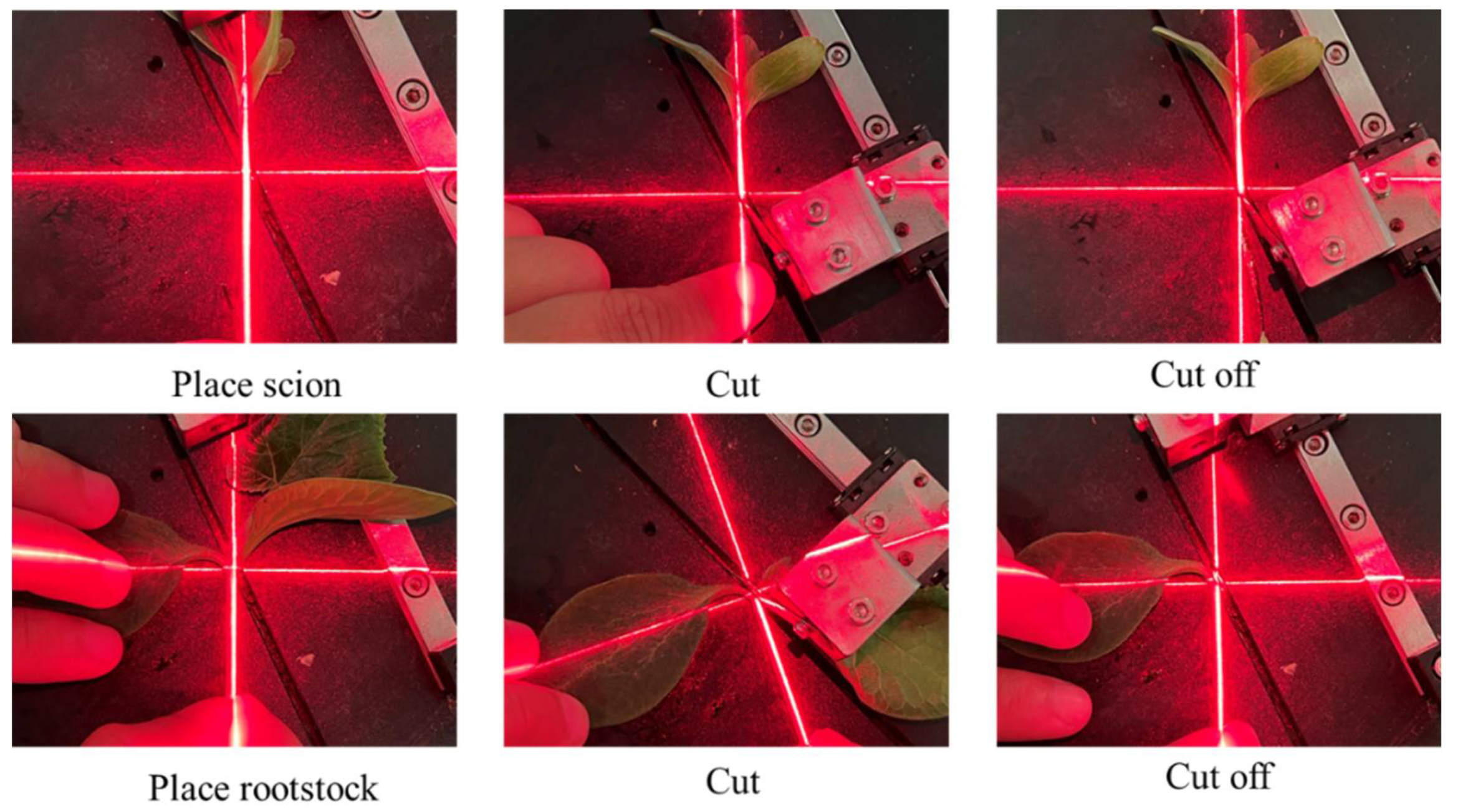
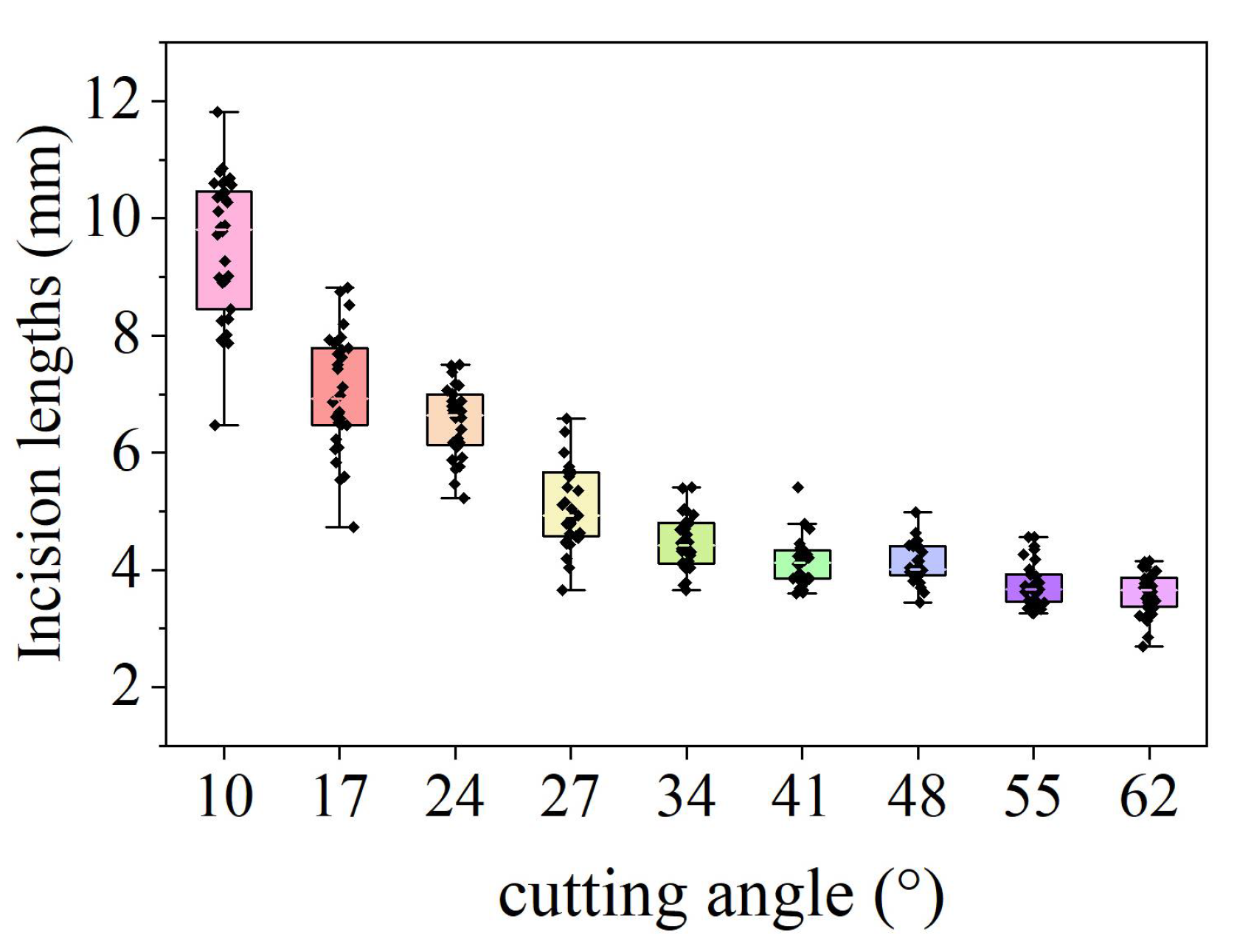
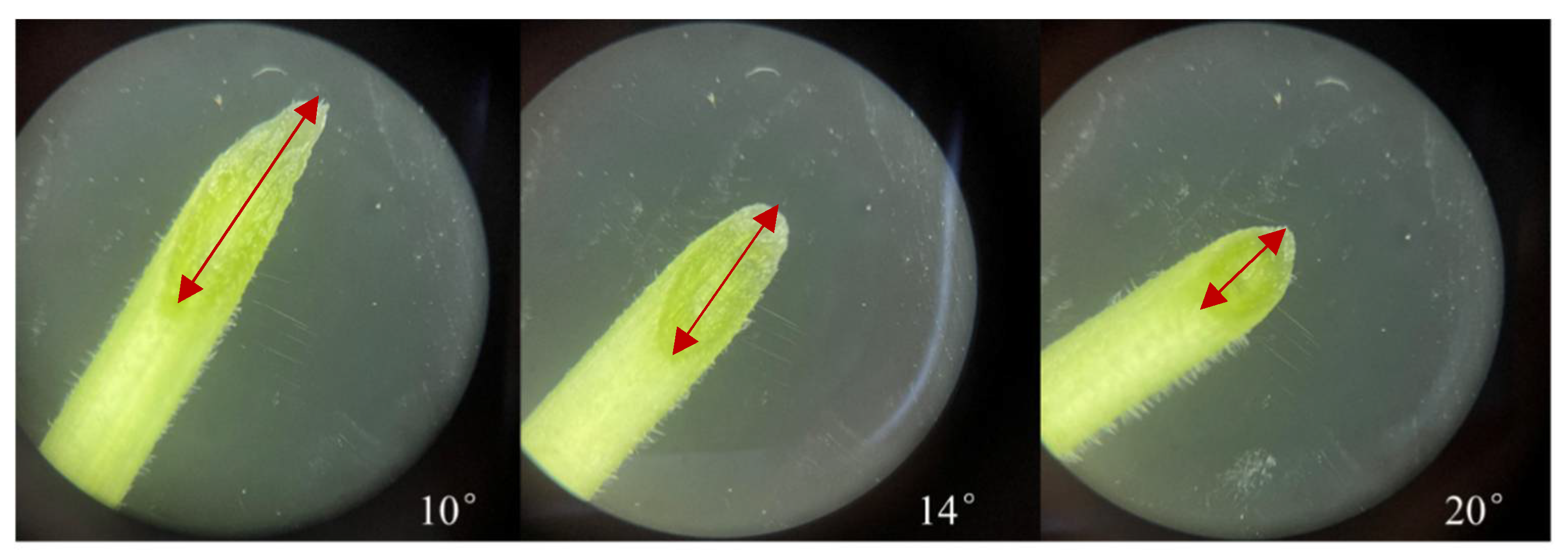
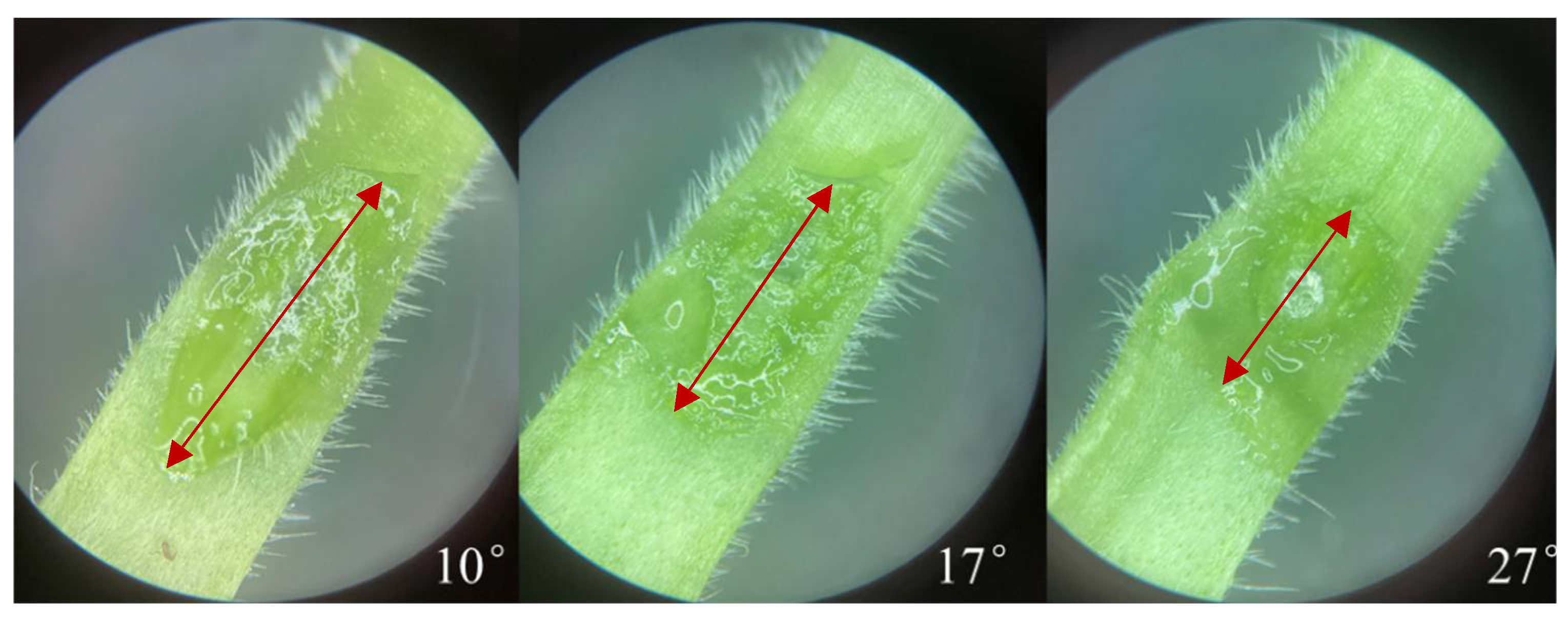
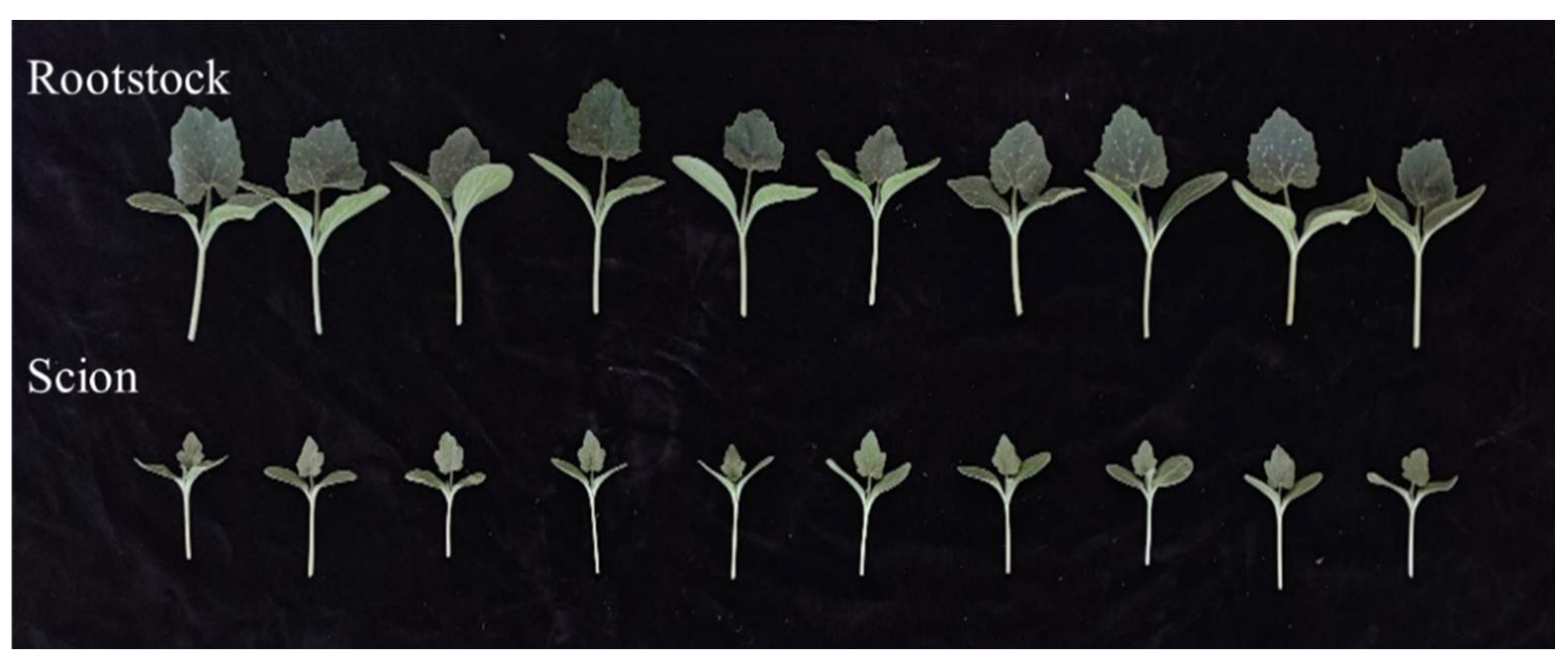
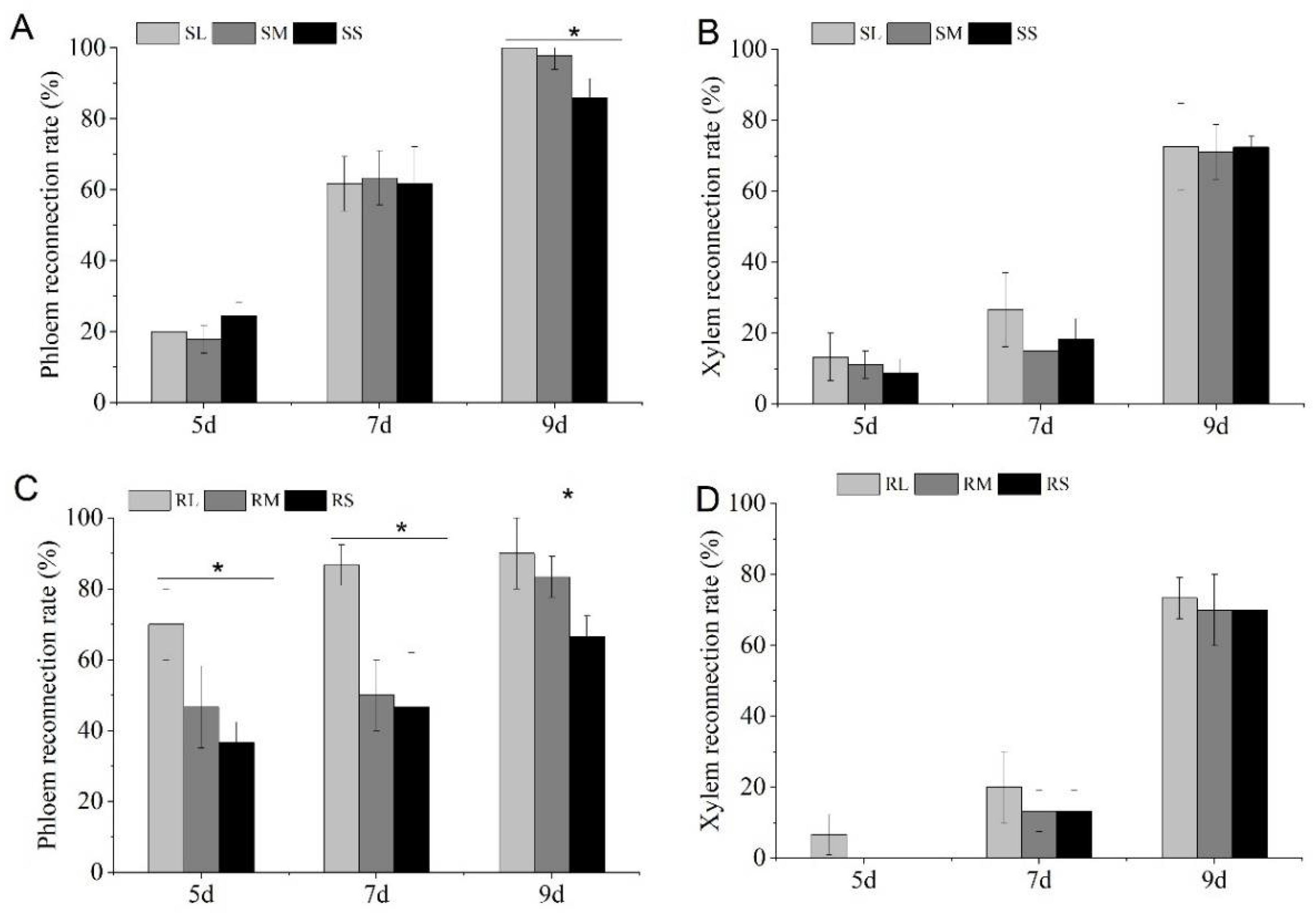
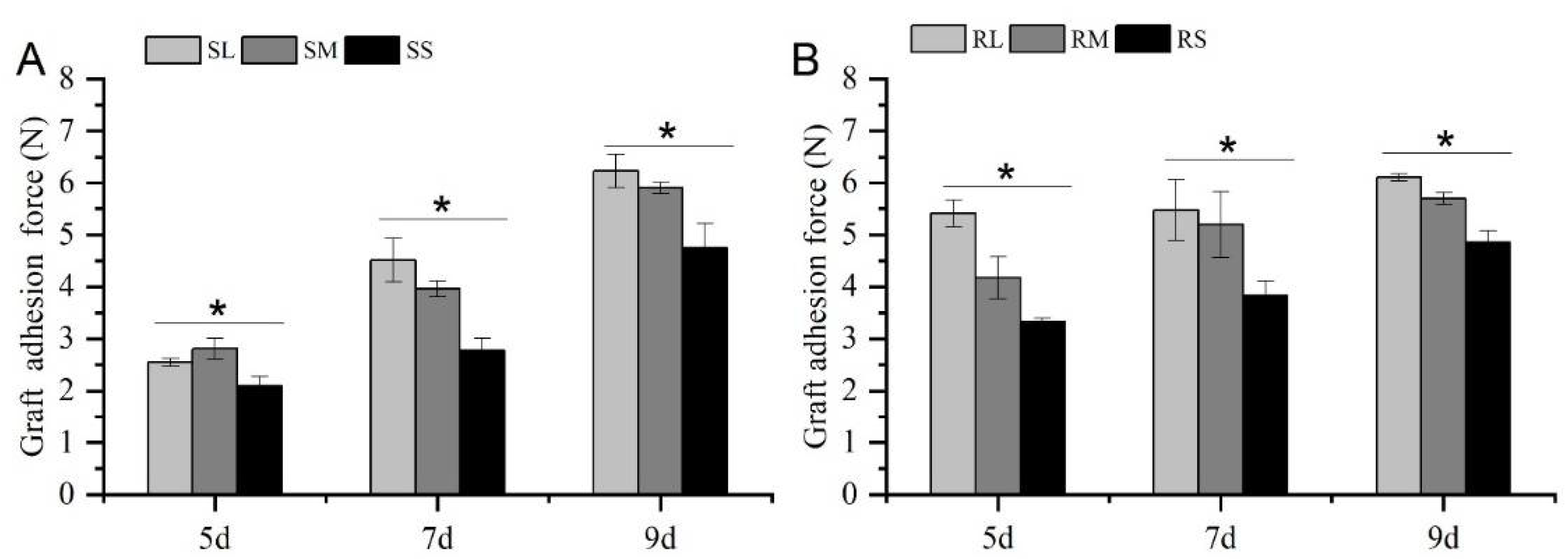
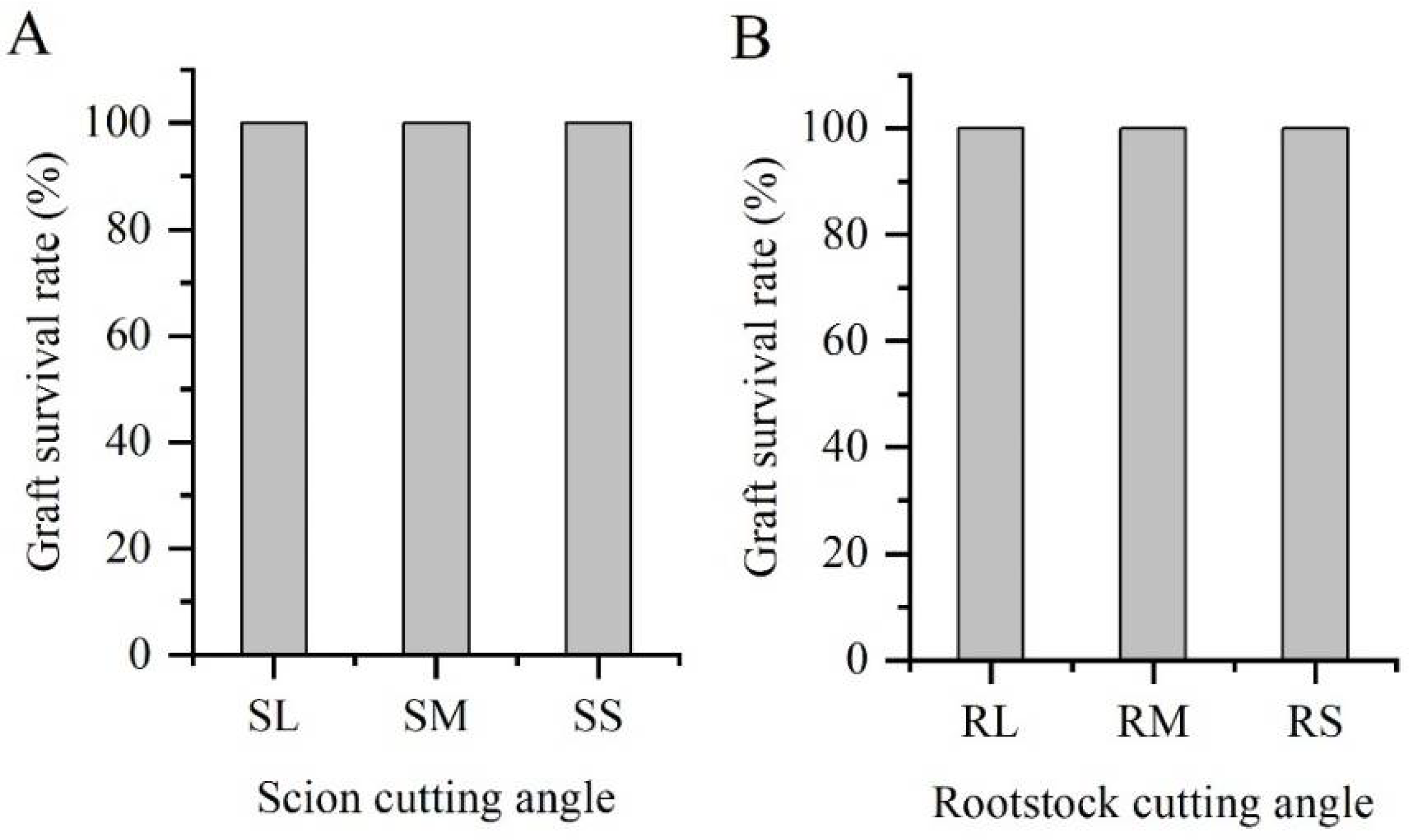
| Treatment | Cutting Angle of Scion (°) | Cutting Angle of Rootstock (°) | ||||
|---|---|---|---|---|---|---|
| 10 | 14 | 20 | 10 | 17 | 27 | |
| Incision lengths (mm) | 7.65 ± 0.80 | 5.48 ± 0.75 | 3.74 ± 0.47 | 8.75 ± 0.30 | 6.46 ± 0.42 | 4.92 ± 0.43 |
| Treatment | Plant Height (mm) | Stem Diameter (mm) | Root Length (mm) | Shoot Dry Weight (mg·Plant−1) | Root Dry Weight (mg·Plant−1) |
|---|---|---|---|---|---|
| SL | 21.10 ± 3.05 a | 2.58 ± 0.14 a | 124.20 ± 2.16 a | 86.36 ± 2.67 b | 7.52 ± 0.26 a |
| SM | 20.71 ± 4.71 a | 2.59 ± 0.23 a | 124.62 ± 3.46 a | 100.18 ± 2.29 a | 7.24 ± 0.20 a |
| SS | 23.33 ± 3.06 a | 2.53 ± 0.15 a | 116.41 ± 0.68 a | 102.43 ± 6.43 a | 7.51 ± 0.40 a |
| RL | 28.65 ± 0.36 a | 3.02 ± 0.13 a | 127.00 ± 7.14 a | 114.98 ± 3.60 a | 9.05 ± 0.55 b |
| RM | 29.20 ± 0.51 a | 2.97 ± 0.08 a | 126.53 ± 0.88 a | 120.52 ± 3.47 a | 11.70 ± 0.85 a |
| RS | 28.79 ± 0.53 a | 3.26 ± 0.13 a | 129.09 ± 5.25 a | 121.92 ± 4.97 a | 11.09 ± 1.00 ab |
Disclaimer/Publisher’s Note: The statements, opinions and data contained in all publications are solely those of the individual author(s) and contributor(s) and not of MDPI and/or the editor(s). MDPI and/or the editor(s) disclaim responsibility for any injury to people or property resulting from any ideas, methods, instructions or products referred to in the content. |
© 2023 by the authors. Licensee MDPI, Basel, Switzerland. This article is an open access article distributed under the terms and conditions of the Creative Commons Attribution (CC BY) license (https://creativecommons.org/licenses/by/4.0/).
Share and Cite
Liang, H.; Jiang, K.; Shi, X.; Zhu, J.; Liu, J.; Wang, D.; Ge, M.; Zhou, M.; Shan, F. An Experimental Study on the Effect of Cutting Angle on the Growth of Grafted Watermelon Seedlings Using the One-Cotyledon Grafting Method. Agronomy 2023, 13, 250. https://doi.org/10.3390/agronomy13010250
Liang H, Jiang K, Shi X, Zhu J, Liu J, Wang D, Ge M, Zhou M, Shan F. An Experimental Study on the Effect of Cutting Angle on the Growth of Grafted Watermelon Seedlings Using the One-Cotyledon Grafting Method. Agronomy. 2023; 13(1):250. https://doi.org/10.3390/agronomy13010250
Chicago/Turabian StyleLiang, Huan, Kai Jiang, Xianfeng Shi, Juhong Zhu, Jiangfeng Liu, Dehuan Wang, Mihong Ge, Mobing Zhou, and Feifei Shan. 2023. "An Experimental Study on the Effect of Cutting Angle on the Growth of Grafted Watermelon Seedlings Using the One-Cotyledon Grafting Method" Agronomy 13, no. 1: 250. https://doi.org/10.3390/agronomy13010250
APA StyleLiang, H., Jiang, K., Shi, X., Zhu, J., Liu, J., Wang, D., Ge, M., Zhou, M., & Shan, F. (2023). An Experimental Study on the Effect of Cutting Angle on the Growth of Grafted Watermelon Seedlings Using the One-Cotyledon Grafting Method. Agronomy, 13(1), 250. https://doi.org/10.3390/agronomy13010250







